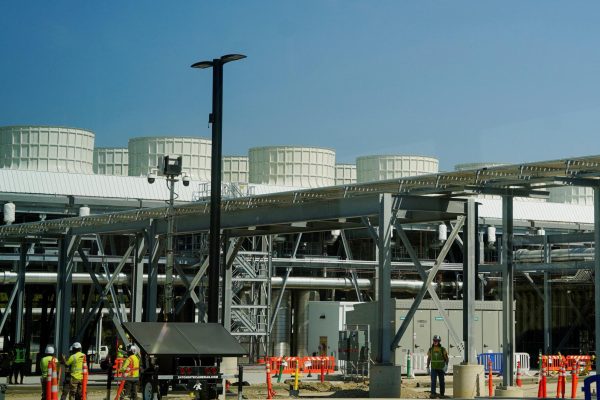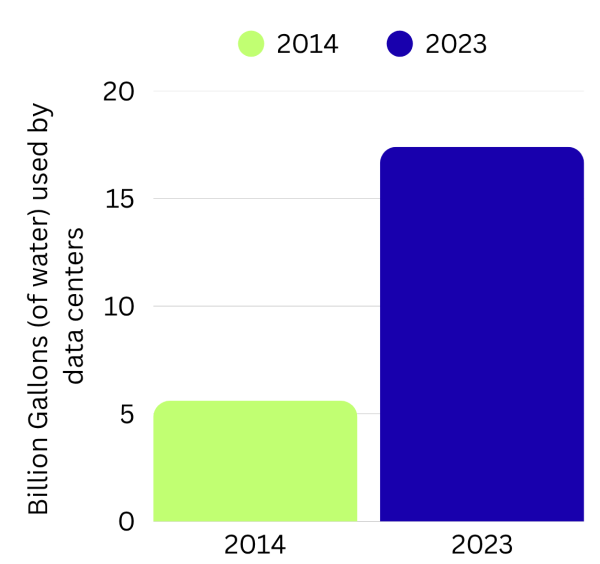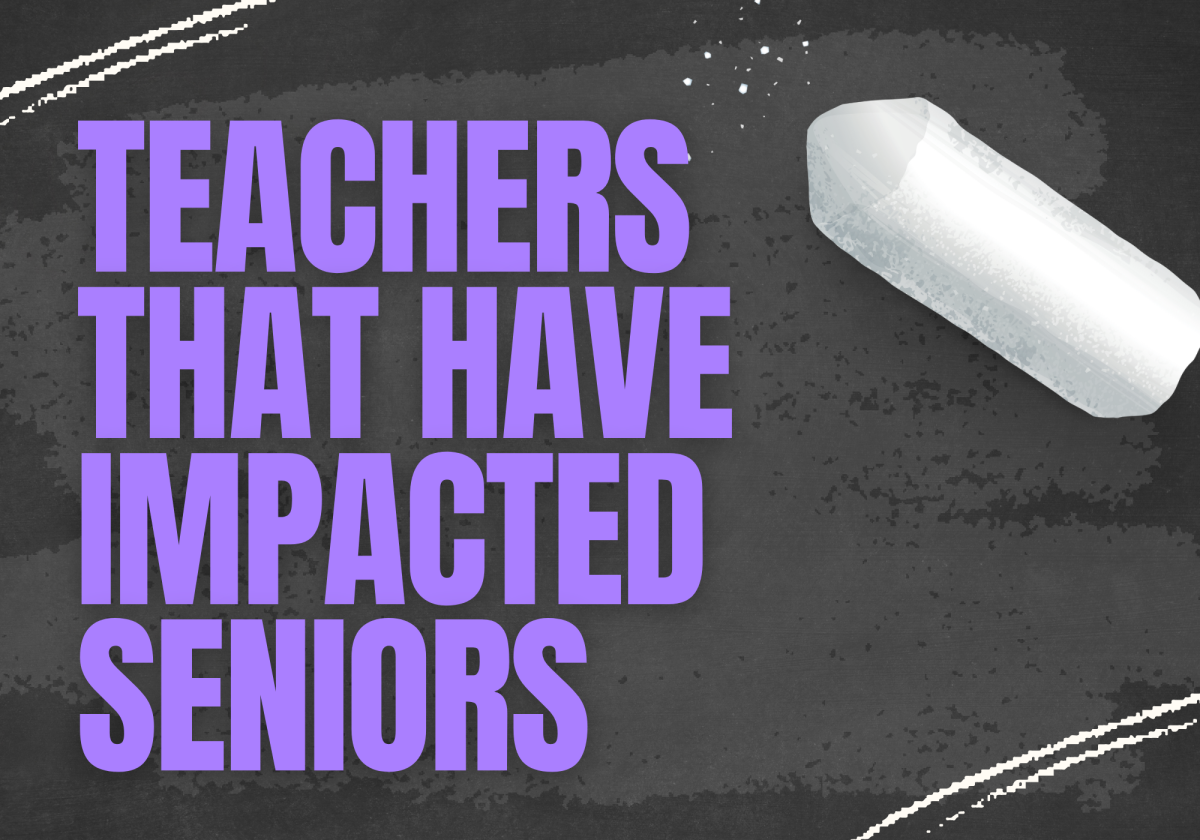Every single decision one makes has an effect. One search on AI uses five to ten times more energy than a simple Google search.
Every time a prompt is entered into ChatGPT or another AI program, users tap into a data center that consumes a significant amount of water and energy. As we transition into a more digitized world, we are setting up a future where we are increasingly reliant on computers and technology; however, this is not sustainable, and we cannot ignore AI’s digital footprint on the environment for much longer.
Whenever someone enters a prompt into an AI chatbot, the information is sent to a data center where servers process the request and respond using a complex, energy-intensive process. Data centers house the computers that store, manage, and process all of the system’s data. Data enters computers through high-speed network cables, and as information is processed, networks must connect to different servers, allowing data to be transferred through the center and back to the user.
These centers use extensive energy and generate a lot of heat. The heat generated needs to be cooled down to keep the computers and AI data centers running. The most common cooling system is the evaporation cooling system, and using water is the quickest way to cool down these servers. Companies have hoped to switch to clean energy, instead of relying on fossil fuels; however, clean energy like solar or wind cannot keep up with the energy demand of AI.

Meta claimed it entered a 20-year corporate nuclear energy agreement with Constellation Energy to build the Clinton Clean Energy Center, which is claimed to produce enough electrical power to power the equivalent of 800,000 homes. With this agreement, Meta would be investing into geothermal and nuclear energy. However, nuclear energy is controversial because, while it is clean energy, power plants leave radioactive pollution, which can easily become dangerous.
Rods, which absorb nuclear energy, take hundreds of thousands of years to decompose according to the United States Nuclear Regulatory Commission, or the U.S.NRC. Nuclear power can also pose a threat since a nuclear meltdown can be extremely dangerous, as seen in Chernobyl, Ukraine, in 1986. So, while companies are making clean energy efforts, it isn’t a solution for right now.
Large-scale data processing, such as AI, further intensifies heat generation in the data centers. This means that since the growth of artificial intelligence, more power and water are needed to cool down the computers, and more data centers need to be built to keep up with the energy and AI demand.
In an article from Stanford University, an Energy Department report noted that in 2014, U.S. data centers used 5.6 billion gallons of water. By 2023, 84% of the water was used to run the larger “hyperscale” centers, and the total water use had tripled to 17.4 billion gallons per year.

The extensive water use creates problems for nearby communities by affecting water quality and energy availability. It’s even worse in hotter areas already plagued by seasonal droughts.
“I believe it is becoming a problem because the amount of water it utilizes to push out responses and images is way too much. We need water to function; without it, we will suffer dangerous consequences. It’s even scarier because AI uses fresh water, and we don’t have a lot of that,” junior Aaliyah Evans said.
In an article written by Stanford University, data center water consumption is a concern, specifically in desert areas like Arizona. Phoenix, Arizona, has limited home construction to preserve groundwater. APM Research Lab reported that Meta’s data center in Goodyear, Arizona, which is west of Phoenix, used “around 56 million gallons of potable water annually, equivalent to 670 Goodyear households.”
E-waste, or electronic waste, is just another way AI negatively impacts the environment. In an article on Geneva’s Environmental Network, they highlighted how, typically, the computers used in data centers last three to five years. These computers use limited resources like lithium, silicon, copper, and other materials that are hard to mine. Lithium, which is typically mined in South America, is especially bad for the environment. Mining can degrade the soil, create water shortages, and cause ecosystem destruction, which leads to biodiversity loss. Since more data centers are being built to sustain the demand for new AI technology, the demand for lithium has increased.
“I have definitely heard about the environmental problems AI has caused. I feel a multitude of emotions. In a sense, I feel a little hopeless because a large portion of generative AI tools made available are by large corporations. I think everyday people do not care or are not informed enough about this issue, and unfortunately, won’t until their own comfort is possibly disrupted by the environmental effects of AI, among other factors,” said Jordan.
About 2.2 million liters of water are needed to produce one ton of lithium, as stated in an article on greenly.earth. At this rate, the demand for lithium is just too much.
“Pollution by corporations has been taxed to varying degrees in some countries for the past half-century. The use of natural resources and energy leaves behind an ecological footprint,” Brown said. “In the case of AI, the materials for buildings, servers, and computer components all require mining that damages land and pollutes water. Additionally, the continued operation of AI requires massive amounts of energy and uses water resources for cooling.”
E-waste is recyclable, but only 22.3% of e-waste is correctly recycled and collected. In 2022, about 61.9 million tons of e-waste were generated, and it has been rising by about 2.6 million tons annually, according to human-i-t.org. When e-waste is tossed in landfills, harmful chemicals seep into the ground, contaminating the water supply, which can affect the local ecosystems as well as the health of people living nearby. To properly dispose of e-waste, there are many recycling centers nearby: https://calrecycle.ca.gov/.

“I find it heavily disturbing how people in higher positions, that being employers and the ambassadors of monopolies, are in such a rush to replace human labor and creativity with soulless artificial intelligence in a transactional society that is built off of the working class,” Jordan said. “I am worried for the next generation of professionals or even students that will be in or are already in positions they are not suited for such as difficult AP classes or higher education courses that will enter a professional environment with like 5% of the expertise they are supposed to have because they have the assistance of AI at their disposal at all times.”
As artificial intelligence increases, many don’t think society is ready to be in such a digitized world that relies on computer-generated information. AI takes so much out of the environment and only puts out information that one can find easily in a book or by doing a quick search.. Instead of asking ChatGPT, people need to focus on a future where members of society build real connections, not just talk to an AI platform. The world is already seeing the effects that humans have had on the environment; AI just exacerbates the problem.
“Despite some useful AI applications, we need to consider the consequences to the environment and natural human intelligence,” Brown said.








